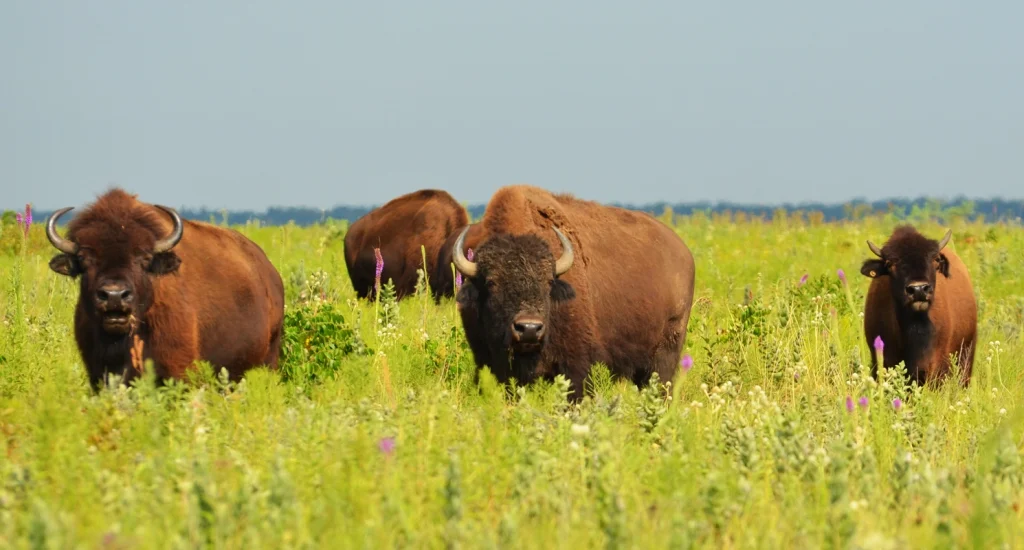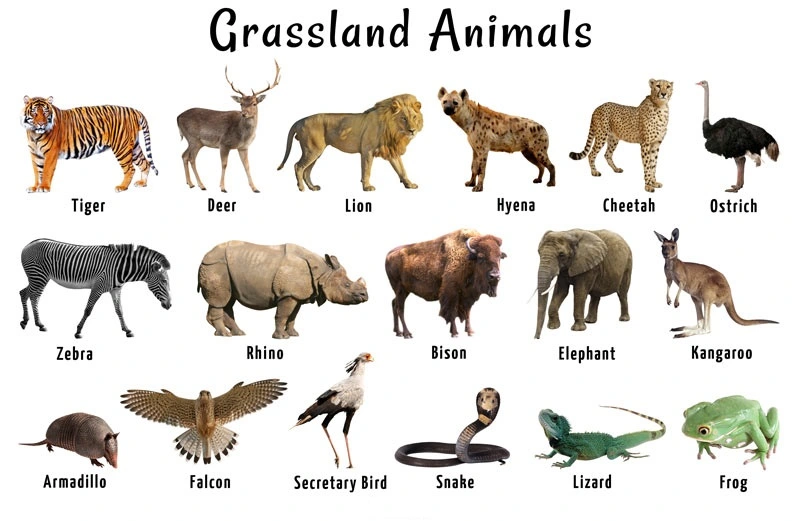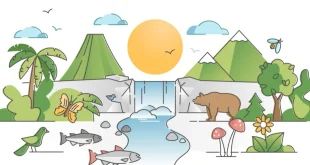
Grassland
Grasslands are areas where grasses dominate over trees or large shrubs. Mountains rose in the western side of North America during the Pliocene and Miocene Epochs, which ended about 25 million years ago and created a continental climate suitable for Grasslands.
Ancient forests declined, and Grasslands flourished. Following the Pleistocene Ice Ages, Grasslands spread across the world as drier and hotter climates succeeded. Grasslands are known by multiple names, such as Grasslands in the USA Midwest are known as prairies. Grasslands are called Pampas in South America.
Except for Antarctica, grasslands are found on all the continents, as the land in Antarctica is covered with thick snow, leaving no choice for any vegetation to break out from the soil. Human beings modify the natural vegetation and give birth to artificial vegetation of crops and pastures. A detailed blog on ” Uncovering the Beauty of Earth’s Major Biomes: An Extensive Compilation” can be seen fromhttps://thecliment.com/uncovering-the-beauty-of-earths-major-biomes/
Types of Grasslands
Grasslands are categorized into two types:
- Savannas or Tropical Grasslands
- Temperate Grasslands
Examples of tropical grassland comprise northern Australia and hot savannas of sub-Saharan Africa.
Savanna or Tropical Grassland
A savanna is a grassland with a few distributed trees. Savannas of one kind or another cover nearly half of Africa’s land about five million square miles, typically in central Africa as well as large areas of South America, Australia, and India.
Savanna is a mix of different grass and trees; their quantity depends directly on the precipitation in that area. Some may range below 0.3m while some can outgrow this and grow approximately 2.1m.

Climate of Tropical Grassland
- Climatic conditions are the most important factor in the formation of a savanna.
- Tropical grasslands are always found in hot or warm climates with annual precipitation ranging from 20-50 inches.
- It is serious that heavy rainfall in six to eight months of the year, followed by a long-time drought during which fires can happen. Many of these areas become Tropical forests if rain falls consistently throughout the year.
- Savannas formed as a result of climatic conditions are called climatic savannas.
- Savannas that are formed by soil conditions and are not entirely maintained by fire are known as Edaphic savannas. These can happen on ridges or steep hills with shallow soil, or in areas with clay soils that become waterlogged in rainy weather.
- Derived savannas are formed when people clear forest land for cultivation.
- Farmers cut down trees, burn the dead ones, and grow crops in the ashes for as long as the soil is fertile. The field then becomes wild, and, while forest trees may recolonize, grass takes over on the bare ground, flourishing enough to burn within a year or so.
- Elephants have created a savanna by eating twigs and leaves and smashing trunks, breaking off branches, and stripping the bark of trees in protected parklands of Africa. Elephants can rapidly turn dense forests into open grassland.
Rainfall Season
- The average yearly Rainfall in savannas is 30-40 inches.
- The savanna has both a wet and dry Season. Seasonal fires are life-threatening to the biodiversity of the tropical grasslands.
- The start of the dry season is in October with a series of fierce thunderstorms followed by a strong drying wind.
- During the dry season, fires are common during January. Poachers often start fires in savannas because they want to clear away dead grass to make it easier to see their prey. The fires do not destroy the community. The majority of the organisms killed in the fires are insects with short lives.
- Some animals, for example, birds, come to fire sites to eat stick insects, grasshoppers, mice, beetles, and lizards that are killed or run away.
- Small organisms can find shelter in crevices and underground holes.
- Larger animals can generally run fast enough to avoid the fire. Although fire burns the dry leaves and stems of grasses, the grass’s deep roots are not harmed. When the soil becomes moist, these roots, with all of their starch deposits are ready to send up new growth.
- The distributed shrubs can also survive on food deposits stored in their roots until the time comes for them to grow above the soil again.
- Trees, unlike shrubs, and grasses can resist fire by retaining moisture in all of their above-ground parts during the dry season.
Location of Tropical Grasslands
- Savannah of the world near the equator produces plants that can survive hot weather for the majority of the year, as well as fires and drought.
- The African savannas are possibly the most well-known, but Tropical Grasslands can also be found in South America, Australia, and India.
- There are llanos in Venezuela and Colombia, Campos in the Brazilian plateaus, Pantanals in plains in Australia, Upper Paraguay, and India’s Deccan Plateau.
- Even though they are all hot, the annual rainfall differs. The Australian plains may only receive 18 inches of rain per annum, but African savannas get more than 50 inches of rain annually.
- South America’s Pantanal and llanos are regularly flooded during a portion of the year.
Tropical Grassland Animals
- Although it may seem that animal life is rare on the savanna, it is flourishing. Elephants, wildebeest, zebras, giraffes, and other browsers eat the grasses on savannas in Africa, which are then fed by cheetahs, lions, and other predators.
- Emus and other scavengers in Australia depend on hot Grasslands. Insects, on the other hand, establish the majority of Animal life in the savannas. There are billions of termites, locusts, and flies here.
- Zebras choose fibrous grass, whereas hartebeest eats plant stubbles left by previous foragers. Elephants and Giraffes eat the trees, and carnivorous animals hide in the long grasses before attacking.
Tropical Grassland Vegetation
- The soil in tropical grasslands is porous which allows water to drain quickly.
- It only has a thin layer of organic soil formed by the partial decomposition of plant or animal matter called humus, which provides nutrients to vegetation. Savannas are sometimes mentioned as forests.
- Forbs and grass are the most common types of vegetation. Forbs are small broad-leaved plants that grow with grasses. Because of changes in rainfall and soil conditions, different savannas support different grasses.
- Because the savanna supports so many species challenging for living space, only one or a few types of grass are usually more effective than the others in the area.
- One type of savanna, known as grouped-tree grassland, is located in southwestern Kenya, Uganda, and Tanzania and characterized by trees that grow only on termite mounds, with the overriding soil being too thin or poorly drained to support tree growth at all.
- Regular fires and large grazing mammals destroy seedlings, keeping the tree and shrub density low.
Threats to Savanna Grassland
Fire: Managing fire is very critical because it can be very dangerous and deadly to the lives of every living being. Fire in a forest is way more upsetting as compared to the cities and villages. Though everything is closely attached and connected, even a small spark can turn the whole forest into ashes very rapidly. Savannas are known for fires occurring regularly.
Animal grazing: Animals don’t graze on closely arranged forests as the trees and grass don’t provide much chance for them to even enter them. On the other hand, the savanna is open-structured and measured as a hub for the grazing animals to enter and graze on the huge fields. Animal grazing affects the soil because when animals graze, they disturb the soil.
Change in the climate: It is said by the researchers that the Savanna is increasing its range in reaction to the visible difference in the climate there and it is possible that the grasslands are shifting dramatically and the distribution of vegetation is changing.
Clearing of trees: The Savannas of South America and Australia are clear of trees now and still going on continuously. The vegetation in these areas is disturbed by thinning down the trees. There are several techniques used in clearing or cutting down woody plants. Heavy machinery is also used for this process.
Temperate Grassland
Temperate grasslands are categorized by the predominant vegetation i.e. grasses. These types of grasslands normally have no trees. Temperatures can differ very much in this biome. In winter, the temperatures can be too low and in summer, the temperature reaches more than 100℉.
Steppes have short grasses whereas, prairies have long grasses but both are Temperate Grasslands. The three most important features of temperate grasslands are their soil, climate, and flora and fauna. An article by UN Habitat on Temperate grasslands. https://www.un-habitat.org/wildlife-in-the-temperate-grassland/

Characteristics of the Temperate Grassland
Different types of grasslands have some same characteristics. Savannas have scattered trees and exist in certain parts of South America, Africa, Asia, and Australia. Temperate grasslands are largely barren of trees with less rainfall than savannas. Prairies have taller grasses whereas steppes have shorter grasses due to higher rainfall. Both types of temperate grasslands exist throughout Europe and North America.
The Climate of Temperate Grassland
Temperate grasslands have a temperate climate with cold winters and hot summers. The temperatures can vary from -40 to more than 100℉.
Rainfall plays a main role in the characteristics of these grasslands. The wetter regions harvest longer grasses which are called prairies in North America, veldt in Africa, and pampas in South America. But the drier regions produce shorter grasses that are called steppes.
The prairie’s annual rainfall differs between 20 and 35 inches. For Steppes annual rainfall differs between 10 and 20 inches. Most rainfall occurs in the spring and early summer.
Soil in Temperate Grassland
The grassroots grows much deeper and has many branches. The decay of roots produces dark, deep, coherent soil that is rich in nutrients and with fertile upper layers. These provide nutrients to the many types of grassland plants and grass that grow here.
Grasslands Animals and Plants
Grasses make up the grassland plants’ life. But, still, many species of flowers grow there. Seasonal droughts and wildfires in the grass prevent the growth of shrubs and large trees. But oaks, willows, and cottonwoods grow where water is available.
Animals such as wild horses, prairie dogs, jackrabbits, bison, deer, and wolves, live in the American prairies. The African veldt has different groups including zebra, gazelles, and rhinoceroses. Steppe fauna also includes mice, rabbits, badgers, antelope, foxes, and many others.
Some Facts Regarding Temperate Grassland
- 25% of the Earth’s surface consists of the grassland biome.
- Grassland biomes are mainly between a desert and a forest.
- Almost around 2% of the original prairies are still found in North America.
- Fires on grasslands can be scattered as fast as 600 feet per minute.
- Forbs are the soft-stemmed and leafy plants that grow in the grasslands that aren’t grasses.
- Prairie dogs live in holes under the prairies.

 The Climent Respect your roots, Protect your planet
The Climent Respect your roots, Protect your planet
